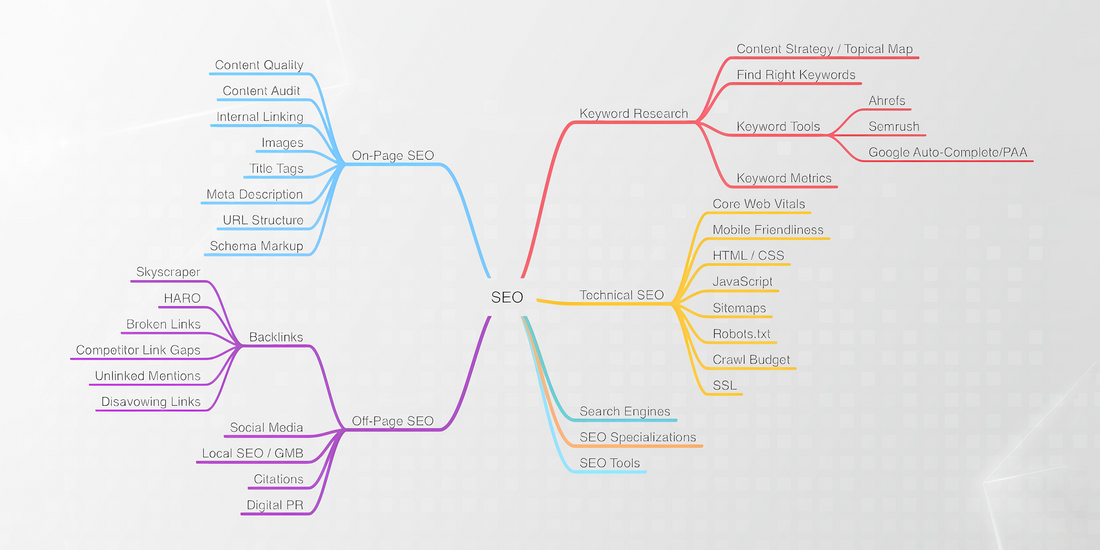How to Create a Topical Map for SEO

If you want to climb the search engine rankings and gain authority in your niche, a well-structured content strategy is the key. One of the most effective strategies is creating a topical map for SEO. Think of it like a mind map for your website, organizing content around main topics and subtopics in a way that both search engines and users love.
By mastering topical mapping, you're not just creating content—you’re building topical authority, which is exactly what search engine crawlers are looking for. So, let’s dive into how to create a topical map that can take your SEO to the next level.
What Is a Topical Map for SEO?
A topical map is a framework that organizes your website’s content into clusters based on related topics and subtopics. It's a bit like plotting a topographic map, where different peaks and valleys represent different levels of content depth.
But why does this matter? Search engines have shifted towards semantic SEO, meaning they focus on understanding the relationship between topics rather than just individual keywords. A topical map helps search engines better comprehend your website’s overall topic relevance, making it easier for them to rank you higher.
Why Do You Need a Topical Map?
Creating a topical map for SEO has several advantages:
- Topical Authority: A well-structured topical map establishes you as an expert in your field. It tells Google, "I know my stuff."
- Better User Experience: When users find relevant content easily, they stay longer, engage more, and come back for more.
- Improved Internal Linking: A solid topical map helps guide your internal linking strategy, which keeps users on your site and signals to search engines that your content is well-organized.
With that in mind, let’s break down the steps to build a topical map that does all this and more.
7 Authoritative Steps for How to Create a Topical Map for SEO
Step 1: Define Your Core Topics
Start by identifying your main topics. These should align with your business goals and the needs of your target audience. To nail this down, you’ll need solid keyword research.
How to Do It:
- Use tools like Ahrefs, SEMrush, or Google Keyword Planner to find high-volume keywords related to your business.
- Focus on search volume, user intent, and competition.
For example, if you run a fitness blog, a core topic might be weight loss strategies.
Step 2: Break It Down Into Subtopics
Once you have your core topics, it's time to break them down into relevant subtopics. Think of these as the smaller, more specific pages that feed into your larger, overarching content.
Example:
If weight loss strategies is your main topic, subtopics might include:
- Low-Carb Diets
- Exercise Routines for Beginners
- Mindful Eating Techniques
Each subtopic will serve as its own web page, offering comprehensive content that supports your core topic.
Step 3: Organize with the Pillar-Cluster Model
Now that you have your topics and subtopics, it’s time to structure them. This is where the Pillar-Cluster Model comes in handy. Your pillar content is a deep dive into your core topic, and each subtopic (cluster) links back to the pillar, creating a strong internal linking web.
How It Works:
- Pillar Content: A long, in-depth page that covers a broad topic.
- Cluster Content: Shorter, focused articles that address specific aspects of the pillar.
Example:
Your pillar page could be The Ultimate Guide to Weight Loss, while your clusters might be Benefits of Low-Carb Diets or Best HIIT Workouts for Fat Loss. Each of these links back to the pillar and to each other.
Step 4: Craft High-Quality Content for Each Subtopic
Now comes the fun part—writing! Each page in your topical map needs to provide valuable, relevant content. Pillar pages should be comprehensive, while cluster pages should focus on specific points.
Tips for Writing:
- Use a mix of short and long sentences for better engagement.
- Incorporate latent semantic indexing (LSI) keywords naturally into your content.
- Make sure each subtopic is focused and concise, answering specific questions.
For instance, your subtopic on HIIT workouts should include details on exercises, duration, and benefits. The content should be actionable and digestible for both users and search engines.
Step 5: Build a Strong Internal Linking Structure
Effective internal linking ties everything together. You want to make sure that every subtopic links back to the main pillar and to other relevant subtopics. This improves the user experience and helps search engines crawl your site more efficiently.
Example:
If you’re writing about Low-Carb Diets, you might link to your Weight Loss Strategies pillar page and another subtopic like Intermittent Fasting.
This way, you’re creating a cohesive content web that signals topical authority to search engines.
Step 6: Optimize for Semantic SEO and User Intent
With your topical map in place, it's time to fine-tune your content for semantic SEO. Search engines care about how well your content satisfies user intent. They look at the overall structure of your content, the natural use of related keywords, and how it addresses what users are searching for.
How to Optimize:
- Use related keywords and phrases naturally throughout your content.
- Make sure your content aligns with what users are trying to achieve.
For example, if someone searches for “best HIIT workout for weight loss,” your article should clearly explain the exercises and benefits, matching the searcher’s intent.
Step 7: Monitor and Update Your Topical Map Regularly
Your content strategy shouldn’t be a one-and-done task. Regularly audit your SEO topical map to find any gaps or outdated content. Update your pillar and cluster content as needed to keep it fresh and relevant.
How to Audit:
- Use tools like Ahrefs or Google Analytics to see how your content is performing.
- Identify new subtopics or questions that your content doesn’t cover yet.
- Expand and improve underperforming content.
By continuously refining your topical map, you’ll maintain a competitive edge and continue to grow your search engine rankings.
Common Mistakes to Avoid
- Keyword Cannibalization: Avoid creating content that competes with itself. Each page should target its own specific keyword.
- Overlapping Topics: Keep your topics distinct. Overlap confuses search engines and dilutes your content’s effectiveness.
- Neglecting Internal Links: Every page in your topical map should link to other relevant pages. This helps users and search engine crawlers alike.
Conclusion
Building a topical map for SEO is about more than just organizing your content. It’s a long-term strategy for building topical authority in your niche, improving internal linking, and crafting content that serves both search engines and users. By following these steps and keeping your topical map updated, you'll not only improve your search engine rankings but also create a more user-friendly, engaging website.
Share via



